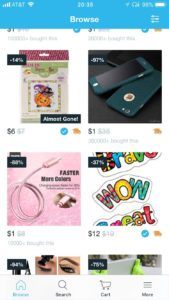what i need to know about wish as a conscientious shopper
Wish, the online marketplace for unbranded goods, is currently the top free shopping app for both iOS and Android, helping to support its $8 billion valuation. The app allows users to shop for millions of SKUs in categories such as clothes, jewelry, and electronics, sold at bargain prices. To offer these bargain prices, users sacrifice delivery speed and product brands, as Wish's products – more often than not unbranded and sourced from the overcapacity of Chinese manufactures – may take ii to four weeks to ship to the U.Due south. or Europe. Wish is growing participants on both sides of its platform: consumers attracted to its depression prices, and merchants, eager to sell excess capacity. Wish now serves over two million orders per 24-hour interval, maintains over 300 1000000 users and earns over $1 billion in acquirement a year.
Demand Side: Wish increases awareness for its platform through an aggressive marketing campaign. In 2016, Wish spent $100 meg on Facebook ads – Facebook's iind highest paying client – and paid between $12-xiv one thousand thousand to accept its logo featured on the Los Angeles Lakers jerseys. Wish also invests VC money heavily into developing its algorithms to help the user-experience functionality. To reduce information asymmetry Wish utilizes a rating system to show the reviews and star-ratings for products – oft with thousands of inputs to ensure the customer of quality. Multi-homing is not necessarily a business organisation for Wish, as consumers may be on both Wish and Amazon, due to their different value propositions. An argument can be fabricated that Amazon can complement Wish, by introducing a previously non e-commerce consumer to online shopping, and then allowing the 2 contrasting value propositions assist the consumer determine which platform is more suited for their purchase or shopping experience.
Supply Side: Wish designs its site to minimize friction points for unbranded manufacturers to list their products. A manufacturer merely uploads a CSV file or manually inputs items to the site and can begin selling immediately. Wish charges a flat charge per unit of xv% of the sale price, per transaction, which it claims covers the cost of connecting the suppliers to a various customers base from previously inaccessible markets: from the U.S. to holland or from Brazil to Commonwealth of australia.
Network effects: Wish offers ii examples of network effects on its platform. First, recruiting suppliers is aided past networks effects, as merchants notice that those who list their products on Wish generally experience increased sales chop-chop. Previously, hesitant suppliers were convinced after listing with Wish, equally a side project, began to deliver reliable and meaningful sales, calendar month afterwards month. Through the increase in suppliers, Wish now offers boosted categories such as Gadgets, Phone Upgrades, Home Décor, Automotive, and Hobbies as a outcome. The more than suppliers that list with Wish, the more the platform'southward supplier interface improves to allow a variety of offerings, and the easier it became to convince future suppliers to join. The increment in suppliers serves every bit a complement to the consumer side, where more suppliers selling their products provides increased offerings for the consumers. The increase in complements from the suppliers increases the demand from the consumers.
The second example of network upshot comes from the consumer algorithm. Equally mentioned, Wish invests heavily into its consumer algorithm and the more than consumers utilize, browse, and both accept and reject Wish products, the more refined Wish's algorithm go, to eventually evidence a browsing consumer more offerings of value. Wish, like many platforms, is fundamentally leveraging its access to consumer data to improve on its value proposition.
Hereafter: Wish'southward success has non gone unnoticed. Both Amazon and Ebay have reacted recently to this value proposition of selling low price items to value-censor consumers. Both platforms have launched new $ten and below market place places designed to compete with Wish. Now that the giants have noticed, a exam of Wish'southward defensible moat for value-conscious consumers will most likely ensue.
Sources
-
 https://techcrunch.com/2016/03/01/the-hot-e-commerce-app-wish-has-hundreds-of-millions-of-users-plus-other-fascinating-stats/
https://techcrunch.com/2016/03/01/the-hot-e-commerce-app-wish-has-hundreds-of-millions-of-users-plus-other-fascinating-stats/ - https://www.nytimes.com/2017/05/03/mag/the-online-marketplace-thats-a-portal-to-the-future-of-capitalism.html?_r=0
- https://www.wsj.com/articles/wish-a-straight-from-cathay-shopping-app-lures-bargain-hunters-1431909072
- https://techcrunch.com/2018/03/02/ebay-joins-amazon-in-battle-with-wish-with-launch-of-an-under-x-storefront/
- https://www.forbes.com/sites/parmyolson/2017/09/twenty/wish-viii-billion-funding-amazon/
- http://www.businessinsider.com/wish-ecommerce-startup-raising-new-round-liquidation-preferences-2016-10
- http://fortune.com/2016/xi/04/wish-e-commerce-startup/
- https://world wide web.youtube.com/scout?five=GuONZw9F1v8
- https://www.recode.net/2017/nine/21/16346286/lakers-sponsorship-jersey-wish-shopping-app
mckinneysymee1942.blogspot.com
Source: https://digital.hbs.edu/platform-digit/submission/wish-the-platform-for-the-cost-conscious-consumer/
0 Response to "what i need to know about wish as a conscientious shopper"
Enregistrer un commentaire